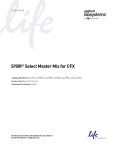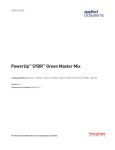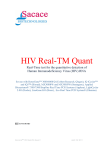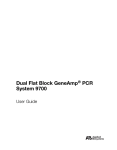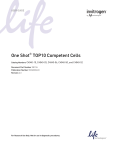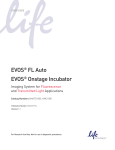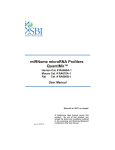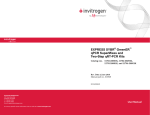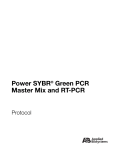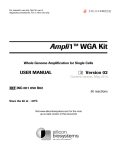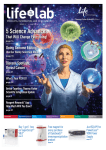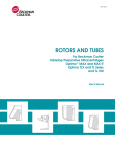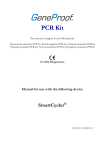Download SYBR® Select Master Mix User Guide (PN 4473367A)
Transcript
user guide SYBR® Select Master Mix Catalog Numbers 4472903, 4472908, 4472918, 4472919, 4472920, and 4472913 Revision Date 3 April 2012 (Rev A) Publication Part Number 4473367 For Research Use Only. Not intended for any animal or human therapeutic or diagnostic use. For Research Use Only. Not intended for animal or human therapeutic or diagnostic use. Information in this document is subject to change without notice. LIFE TECHNOLOGIES DISCLAIMS ALL WARRANTIES WITH RESPECT TO THIS DOCUMENT, EXPRESSED OR IMPLIED, INCLUDING BUT NOT LIMITED TO THOSE OF MERCHANTABILITY OR FITNESS FOR A PARTICULAR PURPOSE. TO THE FULLEST EXTENT ALLOWED BY LAW, IN NO EVENT SHALL LIFE TECHNOLOGIES BE LIABLE, WHETHER IN CONTRACT, TORT, WARRANTY, OR UNDER ANY STATUTE OR ON ANY OTHER BASIS FOR SPECIAL, INCIDENTAL, INDIRECT, PUNITIVE, MULTIPLE OR CONSEQUENTIAL DAMAGES IN CONNECTION WITH OR ARISING FROM THIS DOCUMENT, INCLUDING BUT NOT LIMITED TO THE USE THEREOF, WHETHER OR NOT FORESEEABLE AND WHETHER OR NOT LIFE TECHNOLOGIES IS ADVISED OF THE POSSIBILITY OF SUCH DAMAGES. NOTICE TO PUCHASER: LIMITED LICENSE End Users are specifically not authorized to and are forbidden from reselling, transferring or distributing any products either as a stand alone product or as a component of another product. LIMITED USE LABEL LICENSE: RESEARCH USE ONLY The purchase of this product conveys to the purchaser the limited, non-transferable right to use the purchased amount of the product only to perform internal research for the sole benefit of the purchaser. No right to resell this product or any of its components is conveyed expressly, by implication, or by estoppel. This product is for internal research purposes only and is not for use in commercial applications of any kind, including, without limitation, quality control and commercial services such as reporting the results of purchaser’s activities for a fee or other form of consideration. For information on obtaining additional rights, please contact [email protected] or Out Licensing, Life Technologies, 5791 Van Allen Way, Carlsbad, California 92008. Human diagnostic uses require a separate license from Roche. The right to human in vitro diagnostics requires a separate license. For information on obtaining additional rights, please contact [email protected] or Out Licensing, Life Technologies, 5791 Van Allen Way, Carlsbad, California 92008. TRADEMARKS: The trademarks mentioned herein are the property of Life Technologies Corporation or their respective owners. AmpliTaq is a registered trademark of Roche Molecular Systems, Inc. © 2012 Life Technologies Corporation. All rights reserved. 2 SYBR® Select Master Mix User Guide Contents Product Information ....................................................................................................................................... 4 Chemistry Overview ........................................................................................................................................ 6 Contents and Storage ..................................................................................................................................... 8 Required Materials ......................................................................................................................................... 9 Prevent Contamination and Nonspecific Amplification .............................................................................. 11 Methods...................................................................................................................................................... 13 Procedural Overview .................................................................................................................................... 13 Prepare the Template .................................................................................................................................. 14 Set Up the Plate Document .......................................................................................................................... 15 Prepare the PCR Reaction Plate.................................................................................................................. 16 Run the PCR Reaction Plate ........................................................................................................................ 17 Analyze Your Results .................................................................................................................................... 18 Detect Nonspecific Amplification ................................................................................................................ 22 Troubleshoot ................................................................................................................................................. 24 Appendix A ................................................................................................................................................ 26 Identify Target Sequences and Design Primers ......................................................................................... 26 Optimize Primer Concentrations for PCR ................................................................................................... 28 Appendix B ................................................................................................................................................ 31 Safety ............................................................................................................................................................. 31 Documentation and Support ........................................................................................................................ 33 SYBR® Select Master Mix User Guide 3 Product Information About the Reagent The SYBR® Select Master Mix, is formulated to provide superior specificity and sensitivity. It is supplied in a convenient 2X concentration premix to perform real-time PCR using SYBR® GreenER™ dye. The master mix contains: • SYBR® GreenER™ Dye • AmpliTaq® DNA Polymerase, UP (Ultra Pure) with a proprietary hot start mechanism • Heat-labile Uracil-DNA Glycosylase (UDG) • ROX™ dye Passive Reference • dNTP blend containing dUTP/dTTP • Optimized buffer components The user only needs to provide primers, template, and water. Hot Start The AmpliTaq® DNA Polymerase, UP is provided in an inactive state to automate the hot start PCR technique and allow flexibility in the reaction setup, including pre-mixing of PCR reagents at room temperature. The polymerase is equipped with a proprietary hot start mechanism that provides improved specificity. The polymerase is re-activated after a 2 minute incubation at 95°C. UDG SYBR® Select Master Mix contains heat-labile uracil-DNA glycosylase (UDG). UDG is also known as uracil-N-glycosylase (UNG). Treatment with heat-labile UDG can prevent the reamplification of carryover PCR products by removing any uracil incorporated into single- or doublestranded amplicons (Longo et al., 1990). Heat-labile UDG prevents reamplification of carryover PCR products in an assay if all previous PCR for that assay was performed using a dUTP-containing master mix. See “Prevent Contamination and Nonspecific Amplification” on page 11 for more information about UDG. PCR products are stable for up to 72 hours post-amplification using master mixes containing heat-labile UDG. Unlike standard UDG, heat-labile UDG is completely inactivated prior to amplification. dUTP/dTTP A blend of dUTP/dTTP is included to enable UDG activity and maintain optimal PCR results. SYBR® GreenER ™ The SYBR® GreenER™ dye detects PCR products by binding to double stranded DNA formed during PCR (see Chemistry Overview section). The SYBR® GreenER™ dye provides both higher sensitivity and lower PCR inhibition than SYBR® Green I dye. It can be used on real-time PCR instruments calibrated for SYBR® Green I dye without any change of filters or settings. ROX Passive Reference SYBR® Select Master Mix contains ROX™ dye Passive Reference. The ROX™ dye Passive Reference provides an internal reference to which the reporter-dye signal can be normalized during data analysis. Normalization is necessary to correct for fluorescence fluctuations due to changes in concentration or volume. 4 SYBR® Select Master Mix User Guide Real-Time Instruments About This Protocol SYBR® Select Master Mix can be used to run experiments on the following Life Technologies Real-Time PCR Systems: • StepOne™ Real-Time PCR System • StepOnePlus™ Real-Time PCR System • 7500 Real-Time PCR System • 7500 Fast Real-Time PCR System • 7900HT Real-Time PCR System • 7900HT Fast Real-Time PCR System • ViiA™ 7 Real-Time PCR System • QuantStudio™ 12K Real-Time PCR System This protocol provides: • Background information about gene quantification assays • A list of equipment and materials for using the SYBR® Select Master Mix • Procedures for using the SYBR® Select Master Mix For details about specific procedures described in this protocol, see “Support Documents” on page 33. SYBR® Select Master Mix User Guide 5 Chemistry Overview How the SYBR® GreenER ™ Dye Chemistry Works The SYBR® GreenER™ dye is used to detect PCR products by binding to doublestranded DNA formed during PCR. The process works as follows: 1. When SYBR® Select Master Mix is added to a sample, SYBR® GreenER™ dye immediately binds to all double-stranded DNA. 2. During the PCR, AmpliTaq® DNA Polymerase, UP amplifies the target sequence, which creates the PCR product, or “amplicon.” 3. The SYBR® GreenER™ dye then binds to each new copy of double-stranded DNA. 4. As the PCR progresses, more amplicon is created. Because the SYBR® GreenER™ dye binds to all double-stranded DNA, the result is an increase in fluorescence intensity proportional to the amount of double-stranded PCR product produced. The following figure illustrates this process. Step 1 The SYBR® GreenER™ dye within the SYBR® Select Master Mix immediately binds with all double-stranded DNA Step 2 Step 3 During PCR, AmpliTaq® DNA Polymerase, UP amplifies each target. The SYBR® GreenER™ dye then binds to each new copy of doublestranded DNA. Figure 1 Representation of how the SYBR® GreenER™ dye acts on doublestranded DNA during one extension phase of PCR 6 SYBR® Select Master Mix User Guide Using the Master Mix in Two-Step RT-PCR When performing a two-step RT-PCR reaction, total or mRNA must first be transcribed into cDNA: 1. In the reverse transcription (RT) step, cDNA is reverse transcribed from total RNA samples using random primers from the High-Capacity cDNA Reverse Transcription Kit or SuperScript® VILO™ cDNA Synthesis Kit (see page 10). 2. In the PCR step, PCR products are synthesized from cDNA samples using the SYBR® Select Master Mix. Figure 2 Two-step RT-PCR SYBR® Select Master Mix User Guide 7 Contents and Storage Contents Item The SYBR® Select Master Mix is supplied in a 2X concentration. Part Number Contents Mini-Pack 4472903 One 1-mL tube (100 × 20-µL reactions) 1-Pack 4472908 One 5-mL tube (500 × 20-µL reactions) 2-Pack 4472918 2 × 5-mL tubes (1000 × 20-µL reactions) 5-Pack 4472919 5 × 5-mL tubes (2500 × 20-µL reactions) 10-Pack 4472920 10 × 5-mL tubes (5000 × 20-µL reactions) Bulk Pack 4472913 One 50-mL tube (5000 × 20-µL reactions) Storage 8 Store the SYBR® Select Master Mix at 2°C to 8°C. SYBR® Select Master Mix User Guide Required Materials Plates Instrument ViiA™ 7 and QuantStudio™ 12K systems StepOne™ system StepOnePlus™ and 7500 Fast systems 7900HT and 7900HT Fast§ systems 7500 system Choose the plate appropriate for your real-time instrument. Plates‡ Catalog number MicroAmp® Fast Optical 96-Well Reaction Plate with Barcode (0.1-mL) • 20 plates • 200 plates MicroAmp® Fast Optical 96-Well Reaction Plate with Barcode • 20 plates • 500 plates MicroAmp® Optical 384-Well Reaction Plate with Barcode • 50 plates • 500 plates • 1000 plates MicroAmp® Fast Optical 48-Well Reaction Plate, 20 plates MicroAmp® Fast Optical 96-Well Reaction Plate with Barcode (0.1-mL) • 20 plates • 200 plates MicroAmp® Fast Optical 96-Well Reaction Plate with Barcode (0.1-mL) • 20 plates • 200 plates MicroAmp® Optical 96-Well Reaction Plate with Barcode • 20 plates • 500 plates MicroAmp® Optical 384-Well Reaction Plate with Barcode • 50 plates • 500 plates • 1000 platesv MicroAmp® Optical 96-Well Reaction Plate with Barcode • 20 plates • 500 plates 4346906 4366932 4306737 4326659 4309849 4326270 4343814 4375816 4346906 4366932 4346906 4366932 4306737 4326659 4309849 4326270 4343814 4306737 4326659 § Requires a MicroAmp® Snap-On Optical Film Compression Pad (Cat. no. 4333292) when using the standard MicroAmp® Optical 96-Well Reaction Plate. Optical Seals Seal all plates, except StepOne™ system plates, with MicroAmp® Optical Adhesive Film. Seal StepOne™ system plates with MicroAmp® 48-Well Optical Adhesive Film. Item MicroAmp® 48-Well Optical Adhesive Film: • 25 covers • 100 covers MicroAmp® Optical Adhesive Film: • 25 covers • 100 covers SYBR® Select Master Mix User Guide Catalog number 4375928 4375323 4360954 4311971 9 Other Kits Item High Capacity cDNA Reverse Transcription Kit: • 200 reactions • 200 reactions with RNase Inhibitor • 1000 reactions • 1000 reactions with RNase Inhibitor SuperScript® VILO™ cDNA Synthesis Kit: • 50 reactions • 250 reactions Catalog number 4368814 4374966 4368813 4374967 4453650 4453651 Other Consumables Item Centrifuge with adapter for 96-well plates Source Major laboratory supplier (MLS) Centrifuge with adapter for 384-well plates Disposable gloves Microcentrifuge Pipette tips, with filter plugs Pipettors, positive-displacement or air-displacement Polypropylene tubes Tris-EDTA (TE) Buffer, pH 8.0 Vortexer MLS MLS MLS MLS MLS MLS MLS or 10 SYBR® Select Master Mix User Guide Prevent Contamination and Nonspecific Amplification Overview PCR assays require special laboratory practices to avoid false positive amplifications. The high throughput and repetition of these assays can lead to amplification of a single DNA molecule. Using UDG to Minimize Reamplification Carryover Products SYBR® Select Master Mix contains heat-labile uracil-DNA glycosylase (UDG). UDG is also known as uracil-N-glycosylase (UNG). Treatment with heat-labile UDG is useful in preventing the reamplification of carryover PCR products. The heat-labile UDG used in the SYBR® Select Master Mix is a 26-kDa recombinant enzyme derived from the thermolabile UDG gene isolated from marine bacteria, and expressed in E. coli. UDG acts on single- and double-stranded dU-containing DNA. It acts by hydrolyzing uracil-glycosidic bonds at dU-containing DNA sites. The enzyme causes the release of uracil, thereby creating an alkali-sensitive apyrimidic site in the DNA. The enzyme has no activity on RNA or dT-containing DNA (Longo et al., 1990). Using NTC Controls No Template Control (NTC) reactions can be used to identify PCR contamination. NTC reactions contain all reaction components (SYBR® Select Master Mix, primers, water) except sample, and therefore should not return a CT value. Design Primers to Avoid PrimerDimers Use primers that contain dA nucleotides near the 3´ ends so that any primerdimer generated is efficiently degraded by UDG at least as well as any dUcontaining PCR products. The farther a dA nucleotide is from the 3´ end, the more likely partially degraded primer-dimer molecules can serve as templates for a subsequent PCR amplification. Production of primer-dimers could lower the amplification yield of the desired target region. If primers cannot be selected with dA nucleotides near the ends, consider using primers with 3´ terminal dU-nucleotides. Single-stranded DNA with terminal dU nucleotides are not substrates for UDG (Delort et al., 1985) and, therefore, the primers are not degraded. Biotin-dUMP derivatives are not substrates for UDG. For more information about designing primers, see “Guidelines for Designing Primers” on page 26. Do not use UDG in subsequent amplifications of dU-containing PCR template, such as in nested PCR protocols. The UNG degrades the dU-containing PCR product, preventing further amplification. PCR Good Laboratory Practices When preparing samples for PCR amplification: • Wear a clean lab coat (not previously worn while handling amplified PCR products or used during sample preparation) and clean gloves. • Change gloves whenever you suspect that they are contaminated. • Maintain separate areas and dedicated equipment and supplies for: Sample preparation PCR setup PCR amplification Analysis of PCR products SYBR® Select Master Mix User Guide 11 PCR Good Laboratory Practices, Continued 12 • Never bring amplified PCR products into the PCR setup area. • Open and close all sample tubes carefully. Try not to splash or spray PCR samples. • Keep reactions and components capped as much as possible. • Use a positive-displacement pipette or aerosol-resistant pipette tips. • Clean lab benches and equipment periodically with a 10% bleach solution. SYBR® Select Master Mix User Guide Methods Procedural Overview This diagram is an overview of the procedures for performing gene expression experiments. SYBR® Select Master Mix User Guide 13 Prepare the Template Examine RNA Template Quality After isolating the template, examine its quality and quantity and store it properly. Before using the SYBR® Select Master Mix, you need to synthesize singlestranded cDNA from total RNA or mRNA samples. For optimal performance, the RNA should be: • Between 0.002 and 0.2 µg/µL • Less than 0.005% of genomic DNA by weight • Free of inhibitors of reverse transcription and PCR • Dissolved in PCR-compatible buffer • Free of RNase activity IMPORTANT! If you suspect that the RNA contains RNase activity, add RNase inhibitor to the reverse transcription reaction at a final concentration of 1.0 U/µL. Examine DNA Template Quality Quantitate the Template • Nondenatured • IMPORTANT! It is not necessary to denature the RNA. Denaturation of the RNA may reduce the yield of cDNA for some gene targets. Use both of the following methods to examine DNA quality: • Agarose gel electrophoresis – Purified DNA should run as a single band on an agarose gel. Agarose gels reveal contaminating DNAs and RNAs, but not proteins. • Spectrophotometry – The A260/A280 ratio should be 1.8 to 2.0. Smaller ratios usually indicate contamination by protein or organic chemicals. Spectrophotometry can reveal protein contamination, but not DNA or RNA contamination. Template quantitation is critical for successful PCR reactions. The most common way to determine DNA quantity is to measure the absorbance (optical density or O.D.) of a sample at 260 nm in a spectrophotometer. One O.D. unit is the amount of a substance dissolved in 1.0 mL that gives an absorbance reading of 1.00 in a spectrophotometer with a 1-cm path length. The wavelength is assumed to be 260 nm unless stated otherwise. A260 values can be converted into µg/µL using Beer´s Law: Absorbance (260 nm) = sum of extinction coefficient contributions × cuvette pathlength × concentration The following formulas are derived from Beer’s Law (Ausubel et al., 1998): • Concentration of single-stranded DNA = A260 × 33 µg/µL • Concentration of double-stranded DNA = A260 × 50 µg/µL • Concentration of single-stranded RNA = A260 × 40 µg/µL Note: Absorbance measurements of highly concentrated (O.D. > 1.0) or very dilute (O.D. < 0.05) DNA or RNA samples can be inaccurate. Dilute or concentrate the DNA/RNA to obtain a reading within the acceptable range. Store the Template 14 Store the templates as follows: • Store purified RNA templates at −20°C or −70°C in RNase-free water. • Store purified DNA templates at −20°C or −70°C in TE, pH 8.0. SYBR® Select Master Mix User Guide Set Up the Plate Document Select a Plate for PCR Select a plate appropriate for your real-time instrument Refer to page 9 for part numbers of the plates. Configure the Plate Document For information about configuring plate documents when performing real-time quantification, refer to the appropriate user guides listed in “Support Documents” on page 33. SYBR® Select Master Mix User Guide 15 Prepare the PCR Reaction Plate General Guidelines Reminder About Your Primers • For best results, it is recommended to perform four replicates of each reaction. • Reaction mixes can be prepared depending upon your experimental requirements. Scale the components to be included in the reaction mix according to the number of reactions to be performed. Include an additional 10% of the reaction mix volume to account for variations in pipetting. • If using smaller reaction volumes, scale all components of the reaction mix proportionally. Reaction volumes <10 µL are not recommended. Refer to page 26 for information about identifying target sequences and designing primers. Note: Separate PCR thermal-cycling conditions are required for primers with a Tm <60°C Reagent Handling and Preparation Follow these guidelines to ensure optimal PCR performance. Prior to use: • Mix the SYBR® Select Master Mix thoroughly by swirling the bottle. • Place frozen cDNA samples and primers on ice to thaw. After the samples are thawed, vortex them, then centrifuge the tubes briefly. CHEMICAL HAZARD. SYBR® Select Master Mix (2X) may cause eye, skin and respiratory tract irritation. Read the SDS, and follow the handling instructions. Wear appropriate protective eyewear, clothing, and gloves. Prepare the PCR Reactions 1. Prepare the appropriate number of reactions according to the volumes in the following table: Component 384-Well Plate (10 µL/well) 5 µL Variable 48- Well or 96-Well Plates (20 µL/well) 10 µL Variable SYBR® Select Master Mix (2X) Forward and Reverse Primers‡ cDNA template + RNase-free Variable Variable water§ Total Volume 10 µL 20 µL ‡ For optimal performance, use a range from 150–400 nM of each primer. If performing PCR using StepOne™ or StepOnePlus™ Real-Time PCR Systems, use ≤200 nM of each primer. § For optimal performance, use up to 100 ng of cDNA for each reaction. 2. Mix the components thoroughly, and centrifuge briefly to spin down the contents and eliminate any air bubbles. 3. Transfer the appropriate volume of each reaction to each well of an optical plate. 4. Seal the plate with an optical adhesive cover, and centrifuge the plate briefly to spin down the contents and eliminate any air bubbles. Note: PCR can be performed on the reaction plate at any time up to 72 hours after completing the reaction setup when kept at room temperature. 16 SYBR® Select Master Mix User Guide Run the PCR Reaction Plate Run the plate on a Life Technologies real-time quantitative PCR instrument. See the appropriate instrument user guide for help with programming the thermalcycling conditions or with running the plate. To run the plate: 1. Place the reaction plate in the instrument. 2. Set the thermal cycling conditions using the default PCR thermal-cycling conditions specified in the following tables according to the melting temperature of your primers: Standard Cycling Mode (Primer Tm ≥60°C) Step UDG Activation AmpliTaq® DNA Polymerase, UP Activation Denature Anneal/Extend Temperature 50°C Duration 2 min Cycles Hold 95°C 2 min Hold 95°C 60°C 15 sec 1 min 40 Standard Cycling Mode Primer Tm <60°C Step UDG Activation AmpliTaq® DNA Polymerase, UP Activation Denature Anneal Extend Temperature 50°C Duration 2 min Cycles Hold 95°C 2 min Hold 95°C 55–60°C* 72°C 15 sec 15 sec 1 min 40 *Anneal temperature should be set to the melting point for your primers. 3. Set the instrument to perform a default dissociation step. Note: A dissociation curve can be performed up to 72 hours after the realtime PCR run if the plate is stored in the dark, or up to 24 hours later if the plate is stored exposed to light. 4. Set the reaction volume appropriate for the type of plate being used for your PCR reaction. 5. Start the run. SYBR® Select Master Mix User Guide 17 Analyze Your Results The general process for analyzing the data from gene expression assays requires that you: Baseline and Threshold Values 18 • View the amplification plots. • Adjust the baseline and threshold values to determine the threshold cycles (CT) for the amplification curves. • Use the standard curve method or the relative quantification (∆∆C T) method to analyze the results. Use the software provided with your instrument to automatically calculate or manually set the baseline and threshold for the amplification curves. • Baseline refers to the initial cycles of PCR in which there is little change in fluorescence signal. • The intersection of the threshold with the amplification plot defines the CT in real-time PCR assays. The threshold is set above the background and within the exponential growth phase of the amplification curve. SYBR® Select Master Mix User Guide View the Amplification Plots The instrument software calculates baseline and threshold values for a detector based on the assumption that the data exhibit the “typical” amplification curve. A typical amplification curve, as shown below, has a: • Plateau phase (a) • Linear phase (b) • Exponential (geometric) phase (c) • Background (d) • Baseline (e) SYBR® Select Master Mix User Guide 19 Manually Adjust the Baseline and Threshold Experimental error (such as contamination or inaccurate pipetting) can produce data that deviate significantly from data for typical amplification curves. Such atypical data cause the software algorithm to generate incorrect baseline and threshold values for the associated detector. Reviewing all baseline and threshold values after analysis of the study data is recommended. If necessary, adjust the values manually as described in the appropriate instrument user manual. IMPORTANT! After analysis, you must verify that the baseline and threshold were called correctly for each well by viewing the resulting amplification plots. Baseline Settings See the example amplification plots below to determine whether or not the baseline and threshold settings were correctly set. Baseline Set Correctly The amplification curve begins after the maximum baseline. No adjustment necessary. Baseline Set Too Low The amplification curve begins too far to the right of the maximum baseline. Increase the End Cycle value. Baseline Set Too High The amplification curve begins before the maximum baseline. Decrease the End Cycle value. 20 SYBR® Select Master Mix User Guide Threshold Settings Threshold Set Correctly The threshold is set in the exponential phase of the amplification curve. Threshold settings above or below the optimum increase the standard deviation of the replicate groups. Threshold Set Too Low The threshold is set below the exponential phase of the amplification curve. The standard deviation is significantly higher than that for a plot where the threshold is set correctly. Set the threshold up into the exponential phase of the curve. Threshold Set Too High The threshold is set above the exponential phase of the amplification curve. The standard deviation is significantly higher than that for a plot where the threshold is set correctly. Set the threshold down into the exponential phase of the curve. Analyze the Results Using the SYBR® Select Master Mix, you can perform two types of quantitation: relative and absolute. • • Relative Quantitation Method Relative quantitation compares a target against an internal standard. You can perform relative quantitation using either the standard curve method or the comparative CT method. Absolute quantitation compares the CT of an unknown sample against a standard curve with known copy numbers. Gene expression can be measured by the quantitation of cDNA relative to a calibrator sample. The calibrator sample serves as a physiological reference. In a typical experiment, gene expression levels are studied as a function of a treatment of cells in culture, of patients, or of tissue type. The calibrator sample in each case is the cDNA from the untreated cells or patients, or a specific tissue type. All quantitations are also normalized to an endogenous control (such as GAPDH) to account for variability in the initial concentration and quality of the total RNA, and in the conversion efficiency of the reverse transcription reaction. Resources for Data Analysis For more information about analyzing your data, refer to the appropriate instrument manual available from the Life Technologies website at: www.lifetechnologies.com, or contact Technical Support (see page 33 for a list of support documents). SYBR® Select Master Mix User Guide 21 Detect Nonspecific Amplification Because SYBR® GreenER™ dye detects any double-stranded DNA, check for nonspecific product formation by using dissociation-curve or gel analysis. Dissociation Curves A dissociation curve is a graph that displays dissociation data from the amplicons of quantitative PCR runs. Change in fluorescence, due to a dye or probe interacting with double-stranded DNA, is plotted against temperature. When to Generate Dissociation Curves Note: Because of the presence of heat-labile UDG, you can generate a dissociation curve up to 72 hours after the real-time PCR run on any Life Technologies Real-Time PCR System. An Example The dissociation curves below show typical primer-dimer formation. The specific product is shown with a melting temperature (Tm) of 80.5°C, but the primer-dimer has a characteristically lower Tm of 75°C. Primer-dimers are most prevalent in NTC wells and sample wells containing a low concentration of template. Figure 3 Example of two dissociation curves 22 SYBR® Select Master Mix User Guide ( Optional) Check PCR Product Purity by Agarose Gel Electophoresis Note: Because of the presence of heat-labile UDG, you can verify the absence of nonspecific amplification using agarose gel electrophoresis up to 72 hours after amplification. 1. Load 12 to 15 µL of sample per well on an ethidium bromide-stained agarose gel made with UltraPure™ Agarose 1000 (Cat. no. 16550-100): PCR Fragment Size % Agarose in TBE Buffer % Agarose in TAE Buffer <100 bp 5% 6% 100–250 bp 3% 4% CHEMICAL HAZARD. Ethidium bromide causes eye, skin, and respiratory tract irritation and is a known mutagen (that is, it can change genetic material in a living cell and has the potential to cause cancer). Always use adequate ventilation such as that provided by a fume hood. Read the SDS, and follow the handling instructions. Wear appropriate protective eyewear, clothing, and gloves. 2. Run the gel: For PCR fragments <100 bp, use 80 to 100 V for 45 to 60 min. For PCR fragments 100 to 250 bp, use 100 to 115 V for 1 to 1.5 h. 3. Run samples 1/3 to 1/2 the length of the gel, without letting the dye run off the bottom of the gel. Use a UV lamp to check the migration of the samples. SYBR® Select Master Mix User Guide 23 Troubleshoot Observation High CT values/poor precision or failed PCR reactions Possible Cause Insufficient cDNA template is present Quality of cDNA template is poor Sample degradation Incorrect pipetting. Reduced number of PCR cycles in the thermal cycler protocol Primer-dimer formation and residual polymerase activity Low ∆Rn or Rn values Extension time is too short Primer-dimer formation and residual polymerase activity 24 Action Use up to 100 ng of cDNA template per 20-µL reaction. • Quantify the amount of cDNA template. • Test the cDNA template for the presence of PCR inhibitors. Prepare fresh cDNA, then repeat the experiment. Prepare the reactions as described on page 16. Increase the number of PCR cycles to the default setting of 40 (see page 17). • Prepare the reaction mixes and the reaction plate on ice. • To ensure optimal results, run the reaction plate as soon as possible after completing the reaction setup. If you cannot run a reaction plate within 2 hours after completing the reaction setup, store the reaction plate at 4°C. Use the default thermal profile settings (see page 17). • Prepare the reaction mixes and the reaction plate on ice. • To ensure optimal results, run the reaction plate as soon as possible after completing the reaction setup. If you cannot run a reaction plate within 2 hours after completing the reaction setup, store the reaction plate at 4°C. SYBR® Select Master Mix User Guide Observation Rn vs. Cycle plot is not displayed Extremely high ∆Rn or Rn values Lower ∆Rn values obtained in early cycles High variability across the reaction plate Possible Cause ROX™ dye was not selected as the passive reference when the plate document was set up ROX dye was not selected as the passive reference when the plate document was set up Evaporation CT value is less than 15 ROX dye was not selected as the passive reference when the plate document was set up Evaporation High variability across replicates Reaction mix was not mixed well Fluorescent intensity too high (StepOne™ and StepOnePlus™ systems) Primer concentration is too high SYBR® Select Master Mix User Guide Action Select ROX dye as the passive reference when you set up the plate document. Select ROX dye as the passive reference when you set up the plate document. Make sure that the reaction plate is sealed completely, especially around the edges. Adjust the upper baseline range to a value less than 15. Select ROX dye as the passive reference when you set up the plate document. Make sure that the reaction plate is sealed completely, especially around the edges. Mix the reaction mix gently by inversion, then centrifuge briefly before aliquoting to the reaction plate. Use ≤200 nM of each primer. 25 Appendix A Identify Target Sequences and Design Primers Identify Target Sequence and Amplicon Size Guidelines for Designing Primers A target template is a DNA sequence, including cDNA, genomic DNA, or plasmid nucleotide sequence that you want to amplify. Using Primer Express Software, you design primers to amplify amplicons (segments of DNA) within the target sequence. Shorter amplicons work best. Consistent results are obtained for amplicon size ranges from 50 to 150 bp. Using Primer Express® Software Design primers using Primer Express Software as described in the Primer Express® Version 3.0 Getting Started Guide (PN 4362460) and Online Help. General Guidelines • Do not overlap primer and probe sequences. The optimal primer length is 20 bases. • Keep the GC content in the 30–70% range. • Avoid runs of identical nucleotides. If repeats are present, there must be fewer than four consecutive G residues. • Make sure the last five nucleotides at the 3´ end contain no more than two G and/or C bases. If the template is… Then… DNA plasmid DNA Design the primers as described above. genomic DNA cDNA RNA 26 Design the primers as described above. Also see “Select an Amplicon Site for cDNA” on page 27. Design the primers as described above. SYBR® Select Master Mix User Guide Select an Amplicon Site for cDNA Selecting a good amplicon site ensures amplification of the target cDNA without co-amplifying the genomic sequence, pseudogenes, and related genes. Guidelines • The amplicon should span one or more introns to avoid amplification of the target gene in genomic DNA. • The primer pair must be specific to the target gene; the primer pair does not amplify pseudogenes or other related genes. • Design primers according to Primer Express Software guidelines. • Test the amplicons, then select those that have the highest signal-to-noise ratio (that is, low CT with cDNA and no amplification with no template control or genomic DNA). • If no good sequence is found, you may need to examine the sequence and redesign the amplicon or to screen for more sites. If the gene you are studying does not have introns, then you cannot design an amplicon that amplifies the mRNA sequence without amplifying the genomic sequence. In this case, you may need to run RT minus controls. SYBR® Select Master Mix User Guide 27 Optimize Primer Concentrations for PCR Overview Quantitate the Primers By independently varying the forward and reverse primer concentrations, you can identify the primer concentrations that provide optimal assay performance. The primer concentrations you select should provide a low CT and a high ∆Rn when run against the target template, but should not produce nonspecific product formation with NTCs. 1. Measure the absorbance (at 260 nm of a 1:100 dilution) of each primer oligonucleotide in TE buffer. 2. Calculate the sum of extinction coefficient contributions for each primer: extinction coefficient contribution = Σ(extinction coefficient × number of bases in oligonucleotide sequence) See “An Example Calculation of Primer Concentration” on page 28 for an example calculation. 3. Calculate the oligonucleotide concentration in µM for each primer: absorbance at 260 nm = sum of extinction coefficient contribution × cuvette pathlength × concentration/100 Rearrange to solve for concentration: concentration = 100[absorbance at 260 nm / (sum of extinction coefficient contribution × cuvette pathlength)] An Example Calculation of Primer Concentration In this example, the concentration of a primer (in TE buffer, diluted 1:100), with the sequence CGTACTCGTTCGTGCTGC is calculated using the following values: Chromophore Extinction Coefficient A C G T Total 15,200 7050 12,010 8400 — Number of Specific Chromophores in Example Sequence 1 6 5 6 — Extinction Coefficient Contribution 15,200 42,300 60,050 50,400 167,950 measured absorbance at 260 nm = 0.13 sum of extinction coefficient = 167,950 M-1cm-1 contributions for probe cuvette pathlength = 0.3 cm Absorbance (260 nm) = sum of extinction coefficient contributions × cuvette pathlength × oligonucleotide concentration/100 0.13 = 167,950 M-1cm-1 × 0.3 cm × C/100 C = 258 µM 28 SYBR® Select Master Mix User Guide Determine the Optimal Primer Concentration CHEMICAL HAZARD. SYBR® Select Master Mix is a combustible liquid and vapor (keep away from heat and flame). It may cause eye, skin, and respiratory tract irritation. Read the SDS, and follow the handling instructions. Wear appropriate protective eyewear, clothing and gloves. To optimize primer concentrations for PCR: 1. Prepare a 96-well reaction plate as described below. Use 10 to 100 ng of genomic DNA or 1 to 10 ng of cDNA template. The final concentration of SYBR® Select Master Mix is 1X. Note: The plate configuration accounts for four replicates of each of the following nine variations of primer concentration applied to both template and NTC wells: Reverse Primer (nM) 2. Forward Primer (nM) 150 150 150/150 200 200/150 400 400/150 200 150/200 200/200 400/200 400 150/400 200/400 400/400 Calibrate your instrument for SYBR Green Dye, if necessary. Refer to the instrument user manual for calibration instructions. Note: It is recommended to calibrate your instrument every 6 months. Confirm the Absence of Nonspecific Amplification 3. Load the plate into a Life Technologies real-time PCR system. 4. Program the thermal-cycling conditions according to the information in step 2 on page 17. 5. Run the plate. 6. Compile the results for ∆Rn and CT, then select the minimum forward and reverse primer concentrations that yield the maximum ∆R n values and low CT values. Dissociation curves help you select the optimal primer concentrations for your SYBR quantification assays. 1. Review the linear view of the amplification plot in your NTC wells. Note: In Figure A-1 on page 30, part a, the strong amplification of the NTC wells indicates that significant nonspecific amplification is occurring. 2. Generate a dissociation curve with your Real-Time PCR System. Note: In the example dissociation curve data shown in Figure A-1 on page 30, part b, the melting temperature of the product generated in the absence of template is lower than the melting temperature of the specific product generated with template. This variation is typical of primer-dimer formation, and it indicates that lower primer concentration may provide optimal results. SYBR® Select Master Mix User Guide 29 Example of Nonspecific Amplification Figure A-1 Amplification data using SYBR® Green dye chemistry (a) Amplification plot (linear view) demonstrating suspected nonspecific amplification in NTC wells. (b) Dissociation curve analysis confirming that product in NTC wells has a melting temperature different from the specific product. 30 SYBR® Select Master Mix User Guide Appendix B Safety Chemical Safety Guidelines To minimize the hazards of chemicals: • • • • • Chemical Waste Safety Guidelines Read and understand the Safety Data Sheets (SDSs) provided by the chemical manufacturer before you store, handle, or work with any chemicals or hazardous materials. Minimize contact with chemicals. Wear appropriate personal protective equipment when handling chemicals (for example, safety glasses, gloves, or protective clothing). For additional safety guidelines, consult the SDS. Minimize the inhalation of chemicals. Do not leave chemical containers open. Use only with adequate ventilation (for example, fume hood). For additional safety guidelines, consult the SDS. Check regularly for chemical leaks or spills. If a leak or spill occurs, follow the manufacturer’s cleanup procedures as recommended in the SDS. Comply with all local, state/provincial, or national laws and regulations related to chemical storage, handling, and disposal. To minimize the hazards of chemical waste: • Read and understand the Safety Data Sheets (SDSs) provided by the manufacturers of the chemicals in the waste container before you store, handle, or dispose of chemical waste. • Provide primary and secondary waste containers. (A primary waste container holds the immediate waste. A secondary container contains spills or leaks from the primary container. Both containers must be compatible with the waste material and meet federal, state, and local requirements for container storage.) • Minimize contact with chemicals. Wear appropriate personal protective equipment when handling chemicals (for example, safety glasses, gloves, or protective clothing). For additional safety guidelines, consult the SDS. • Minimize the inhalation of chemicals. Do not leave chemical containers open. Use only with adequate ventilation (for example, fume hood). For additional safety guidelines, consult the SDS. • Handle chemical wastes in a fume hood. • After emptying the waste container, seal it with the cap provided. • Dispose of the contents of the waste tray and waste bottle in accordance with good laboratory practices and local, state/provincial, or national environmental and health regulations. SYBR® Select Master Mix User Guide 31 Waste Disposal If potentially hazardous waste is generated when you operate the instrument, you must: • Characterize (by analysis if necessary) the waste generated by the particular applications, reagents, and substrates used in your laboratory. • Ensure the health and safety of all personnel in your laboratory. • Ensure that the instrument waste is stored, transferred, transported, and disposed of according to all local, state/provincial, and/or national regulations. IMPORTANT! Radioactive or biohazardous materials may require special handling, and disposal limitations may apply. Biological Hazard Safety BIOHAZARD. Biological samples such as tissues, body fluids, infectious agents, and blood of humans and other animals have the potential to transmit infectious diseases. Follow all applicable local, state/provincial, and/or national regulations. Wear appropriate protective equipment, which includes but is not limited to: protective eyewear, face shield, clothing/lab coat, and gloves. All work should be conducted in properly equipped facilities using the appropriate safety equipment (for example, physical containment devices). Individuals should be trained according to applicable regulatory and company/institution requirements before working with potentially infectious materials. Read and follow the applicable guidelines and/or regulatory requirements in the following: • U.S. Department of Health and Human Services guidelines published in Biosafety in Microbiological and Biomedical Laboratories http://bmbl.od.nih.gov • Occupational Safety and Health Standards, Bloodborne Pathogens (29 CFR§1910.1030; http://www.access.gpo.gov/nara/cfr/waisidx_01/29cfr1910a_01.html). • Your company’s/institution’s Biosafety Program protocols for working with/handling potentially infectious materials. Additional information about biohazard guidelines is available at: http://www.cdc.gov 32 SYBR® Select Master Mix User Guide Documentation and Support Support Documents You can download the following documents from the Life Technologies website at: www.lifetechnologies.com Document All Systems Part number High-Capacity cDNA Reverse Transcription Kit Protocol Primer Express® Software Version 3.0 Getting Started Guide Real-Time PCR Systems Chemistry Guide 4375575 4362460 4348358 StepOne and StepOnePlus Systems Applied Biosystems StepOne™ Real-Time PCR System Getting Started Guide for Relative Standard Curve and Comparative CT (∆∆CT) Experiments Applied Biosystems StepOne™ Real-Time PCR System Getting Started Guide for Standard Curve Experiments Applied Biosystems StepOne™ Real-Time PCR System Installation, Maintenance, and Networking Guide 4376785 4376784 4376782 7500 Fast System Applied Biosystems 7300/7500/7500 Fast Real-Time PCR System Installation and Maintenance Getting Started Guide Applied Biosystems 7300/7500/7500 Fast Real-Time PCR System Relative Quantification Getting Started Guide Applied Biosystems 7300/7500/7500 Fast Real-Time PCR System Absolute Quantification Getting Started Guide 4347828 4347824 4347825 7900HT System Applied Biosystems 7900HT Fast Real-Time PCR System and SDS Enterprise Database User Guide Applied Biosystems 7900HT Fast Real-Time PCR System User Bulletin: Performing Fast Gene Quantification 4351684 4352533 ViiA™ 7 System Applied Biosystems ViiA™ 7 Real-Time PCR System Getting Started Guides Applied Biosystems ViiA™ 7 Real-Time PCR System User Guide 4441434 4442661 QuantStudio™ 12K System Applied Biosystems QuantStudio™ 12K Real-Time PCR System User Guide Obtaining support 4470050 For the latest services and support information for all locations, go to www.lifetechnologies.com At the website, you can: • Access worldwide telephone and fax numbers to contact Technical Support and Sales facilities • Search through frequently asked questions (FAQs) • Submit a question directly to Technical Support ([email protected]) • Search for user documents, SDSs, vector maps and sequences, application notes, formulations, handbooks, certificates of analysis, citations, and other product support documents • Obtain information about customer training • Download software updates and patches SYBR® Select Master Mix User Guide 33 Safety Data Sheets (SDS) Safety Data Sheets (SDSs) are available at www.lifetechnologies.com/support. Certificate of Analysis The Certificate of Analysis provides detailed quality control and product qualification information for each product. Certificates of Analysis are available on our website. Go to www.lifetechnologies.com/support and search for the Certificate of Analysis by product lot number, which is printed on the box. 34 SYBR® Select Master Mix User Guide Headquarters 5791 Van Allen Way | Carlsbad, CA 92008 USA | Phone +1 760 603 7200 | Toll Free in USA 800 955 6288 For support visit www.invitrogen.com/support www.appliedbiosystems.com/support or email [email protected] www.lifetechnologies.com



































